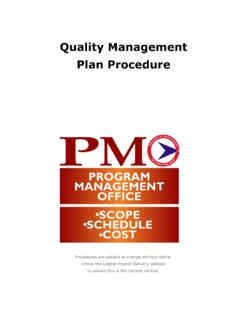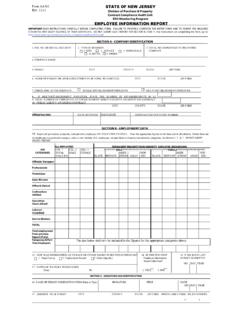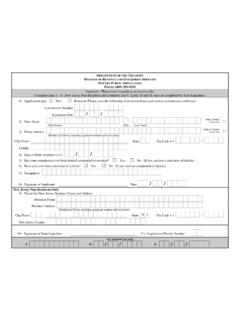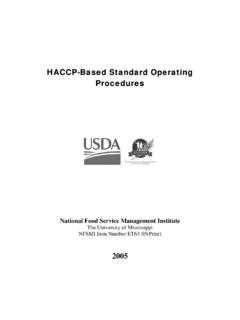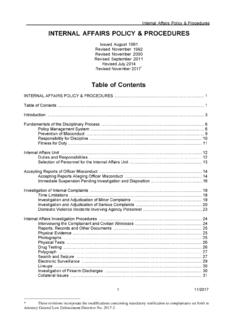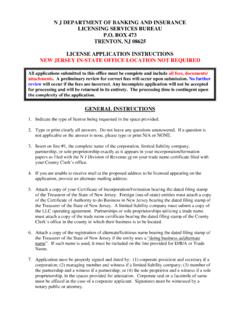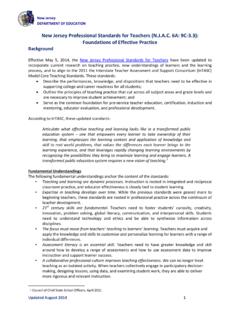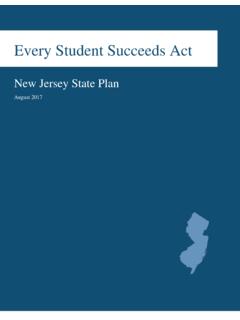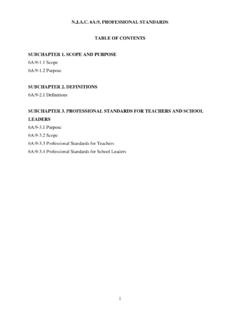Transcription of A-1 Comp. Sales – Comparable Sales Analysis Form
1 NAME:MUNICIPALITY:1 PROPERTY LOCATION:SUBJECT(YOUR HOUSE)#1#2#3 BLOCK/ VALUEXXXXXXXXXXXXXXXXXXXXXXXXXXXXXX3 Sales /PURCHASE PRICE4 DATE OF SALE/PURCHASE5 LOT SIZE6 LOCATION (BETTER, ETC)XXXXXXXXXX7 PROXIMITY TO SUBJECTXXXXXXXXXX8 AGE (YEAR BUILT)9 CONDITION (GOOD, ETC)10 STYLE (RANCH, ETC)11SQ. FT. OF LIVING AREA (GLA)12 NUMBER OF LIVING UNITS13 TOTAL ROOMS/BDRMS/BATHS / / / / / / / /14 BASEMENT (SIZE)/ FINISH / / / /15 TYPE OF HEAT 16 CENTRAL AIR CONDITIONING17 NUMBER OF FIREPLACES18 GARAGE (SIZE)/OUTBLDGS19 PORCHES/DECKS/PATIO20 INGROUND POOL (SIZE)21 MISCELLANEOUS ITEMS22 ADDITIONAL COMMENTS:SUBJECT:SALE #1:SALE #2:SALE #3:THIS form MUST BE SUBMITTED TO THE TAX BOARD (5 COPIES) AND ONE COPY TO BOTH THE MUNICIPAL OR COUNTY ASSESSOR AND MUNICIPAL CLERK NO LATER THAN SEVEN (7) DAYS PRIOR TO YOUR HEARINGCOMPARABLE SALESCOMPARABLE Sales Analysis FORMForm A-1 Comp. Sale (12-14) form A 1 Comp.
2 Sale (12 14) HOW TO PREPARE A Comparable Sales Analysis This Comparable Sales Analysis form is an organizer to help you determine if the equalized assessed value of your property exceeds the market value of your property and to aid you in presenting your argument to the assessor and, if necessary, the county tax board. The first step is to select legally usable Comparable property Sales , , open market Sales between willing buyers and sellers which would be competing with your property if both were offered on the market at the same time. If a typical buyer looking to purchase your property would also consider purchasing your Comparable property, because it has similar utility, location and attractiveness, it s probably a good comparison. Next, use the Comparable Sales Analysis form to compare your property and the properties that have sold. 1. Properties Identification Select at least three, if possible, properties that have sold which are the mostsimilar to your property.
3 On the Block and Lot line, enter your property s identification numbers under subject and the numbers of the first three Comparable properties under Comparable Sales #1, #2 and#3. On the Address line, enter your address and the address of each Comparable property sold. The Q line is only used for condominiums and qualified farm Assessed Value Enter only the assessed value for your property (the subject). Your total assessed value isalready on all completed appeal forms. Remember, you are trying to measure market value, not Sale/Purchase Price Enter the Sales /purchase price as it appears on the deed. You may confirm priceswith public records or with the municipal assessor s Sale Date Enter the Sales date, , closing date or deed date. You may confirm dates with public recordsor with the municipal assessor s Lot Size Enter dimensions, as 50 x 150 (feet), or acres, as acres or .50 acres. Note other aspects ofthe lot as wooded, view, steep, irregular shape, etc.
4 Under Additional Comments. 6. Location Here your property s location is the standard; use comparative terms, for example, similar, better or worse, for each Comparable sale property. Explain any significant differences in location in Additional Comments. 7. Proximity to Subject Estimate the distance, in miles or blocks, between your property and the comparableproperties sold. If a Comparable property is in your immediate area write neighborhood, next door or one block, etc. If you exclude a similar nearby sale property in favor of one that is farther away, youshould be able to explain your Age Enter the year Condition Accurately state the general condition of your property as good, fair, poor, very good, or excellent and the condition of your Comparable Sales properties using the same terms. Be preparedto justify your statements by your own investigation of each sale. View each Comparable property from theexterior and provide at least one photograph of each.
5 Also try to utilize a local multiple listing service,listing agent, or contact the seller, or buyer to ask about the condition of the Comparable Style Identify style as ranch, or one story, colonial or two story, cape or story, bi Level, splitlevel or contemporary, etc. Photos help the assessor and county tax board commissioners recognize thestyle and attractiveness of the Square Feet or Gross Living Area, (GLA) Living area includes all livable space above basement level or abovegrade and is based on gross or exterior dimensions. Exterior dimensions of 25 x 40 and two full storieswould have approximately 2,000 square feet of Gross Living Area. The same exterior dimensions with oneand one half stories would have about 1,500 sq. ft. of GLA. Your assessor can provide this number for yourproperty and each Comparable property sale. Try to settle any factual issues regarding gross living area, etc. with the assessor prior to a county tax board hearing.
6 12. Number of Living Units A single family dwelling is 1 living unit; use 2, 3, or 4 for a two to four family residence. Do not compare a single family dwelling with a multi unit dwelling. You may compare a multi unit dwelling with other multi unit residences having different numbers of dwelling units, as long as they re not single family. An in law or domestic suite is not a multi unit dwelling, unless this suite may be legally rented to a non family member. If so, identify this on this line, as in law suite included, and explain under Additional Comments. 13. Total Rooms/Bedrooms/Baths Report this as 8/4 for an eight room, four bedroom, two and one half bath property; for three half baths in the same property 8/4 Include a bonus room in the room count and explain under Additional Comments. Report basement baths here w/ Added Comments and unusual positive/negative characteristics of the property layout w/Added Comments. 14. Basement Size/Finish Write full, partial, or crawl space or slab if none.
7 Enter percentage of finished area, as 100%, 75%, (three quarters finished) or 50% (half finished). Note if there is a full or half bath on basement level here. Explain quality of the finish and factors as walk out access under Additional Comments. 15. Type of Heat Write in fuel first, as gas, oil electric or other; then if the system is forced air, hot water or steam. Write number as (2) or (3) for properties with 2 or 3 separate systems. 16. Central Air Conditioning Usually a yes or no answer. If the property has central air but it s not operating, still indicate central air is present and explain under Additional Comments. If central air is only for first or second floor of a two story property, for example, write 2nd floor only here. 17. Number of Fireplaces Enter the number, for example, 1 to 4. 18. Garage (size)/Outbuildings Example, write 2 car att. for a two car garage attached to the property or 1 car det. for single car, detached, free standing garage.
8 Typical outbuildings include sheds, barns, cabanas, etc. Explain condition, size and quality etc., under Additional Comments. 19. Porches/Decks/Patios Indicate size, , 10 x 12 or 15 x 25, and character of each. Have a general idea of construction quality and condition. 20. In Ground Pools Report size, , 20 x 40 or 18 x 36, and material, , steel wall with vinyl liner, or concrete/gunite. Note the age, if possible, and overall condition of the pool, as best you can. Removable above ground pools are generally not assessed. 21. Miscellaneous Items Identify and describe. 22. Additional Comments In this area, add comments to cover key aspects of your property (the subject) and each Comparable property which may not be adequately identified on the form , such as flood zone location indicating how often, how severely and when the property last flooded. See example comments on the sample form in these instructions. If you have questions, ask your assessor for help.
9 **Remember you are using your Comparable properties to substantiate the market value of your property (the subject property.) When deciding whether to appeal, it may be useful to evaluate the entries as superior or inferior to your property. If your entries are mostly inferior, the average of the sale prices should be lower than your property s value. If your entries are mostly superior, then the average of the sale prices should be higher than your property s value. If your items are mostly the same, the average of the sale prices of the Comparable Sales properties should be similar to your property s market value. An assessed value should not exceed the market value of a property. All properties in a municipality should be assessed at the same level. Bring this form when you meet with the assessor. Submit this form with all copies of your filed appeal at least seven days prior to your hearing before the county tax board commissioners.
